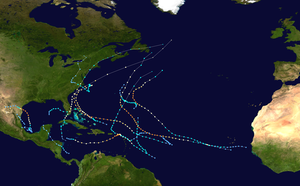
Back موسم أعاصير المحيط الأطلسي 1999 Arabic Atlantische Hurrikansaison 1999 German Temporada de huracanes en el Atlántico de 1999 Spanish Saison cyclonique 1999 dans l'océan Atlantique nord French Atlantisch orkaanseizoen 1999 Dutch Temporada de furacões no oceano Atlântico de 1999 Portuguese 1999 Atlantic hurricane season SIMPLE Atlantiska orkansäsongen 1999 Swedish
This article is currently being merged. After a discussion, consensus to merge this article with content from Tropical Storm Katrina (1999) was found. You can help implement the merge by following the instructions at Help:Merging and the resolution on the discussion. Process started in January 2025. |
| 1999 Atlantic hurricane season | |
|---|---|
 Season summary map | |
| Seasonal boundaries | |
| First system formed | June 11, 1999 |
| Last system dissipated | November 23, 1999 |
| Strongest storm | |
| Name | Floyd |
| • Maximum winds | 155 mph (250 km/h) (1-minute sustained) |
| • Lowest pressure | 921 mbar (hPa; 27.2 inHg) |
| Seasonal statistics | |
| Total depressions | 16 |
| Total storms | 12 |
| Hurricanes | 8 |
| Major hurricanes (Cat. 3+) | 5 |
| Total fatalities | 195 total |
| Total damage | $8.32 billion (1999 USD) |
| Related articles | |
The 1999 Atlantic hurricane season was a fairly active season, mostly due to a persistent La Niña that developed in the latter half of 1998. It had five Category 4 hurricanes – the highest number recorded in a single season in the Atlantic basin, previously tied in 1933 and 1961, and later tied in 2005 and 2020. The season officially began on June 1, and ended on November 30. These dates conventionally delimit the period of each year when most tropical cyclones form in the Atlantic basin. The first storm, Arlene, formed on June 11 to the southeast of Bermuda. It meandered slowly for a week and caused no impact on land. Other tropical cyclones that did not affect land were Hurricane Cindy, Tropical Storm Emily, and Tropical Depression Twelve. Localized or otherwise minor damage occurred from Hurricanes Bret, Gert, and Jose, and tropical storms Harvey and Katrina.
The most significant storm of the season was Hurricane Floyd, a strong Category 4 hurricane that caused devastating flooding along the East Coast of the United States, especially in North Carolina. Damage from the storm totaled approximately $6.5 billion (1999 USD)[nb 1] and there were at least 77 fatalities, making it the deadliest hurricane in the United States since Hurricane Agnes in 1972. Flooding from Floyd in North Carolina followed Hurricane Dennis, a slow and erratic–moving storm that dropped heavy rainfall in the eastern portion of the state. Tropical Depression Eleven in October contributed to extreme flooding in Mexico, which left 636 people dead and caused $491.3 million in damage, though impact could not be distinguished from the storm itself. Hurricane Irene caused extensive flooding in Cuba and Florida, with lesser effects in the Bahamas and North Carolina. Irene was the second–costliest storm of the season, with about $800 million in damage. Hurricane Lenny was an unusual eastward–moving storm in the Caribbean Sea and a strong late–season storm. It caused extensive damage in the Lesser Antilles in the month of November. Collectively, the storms of the 1999 Atlantic hurricane season caused at least 123 fatalities and $8.328 billion in losses.
Cite error: There are <ref group=nb> tags on this page, but the references will not show without a {{reflist|group=nb}} template (see the help page).